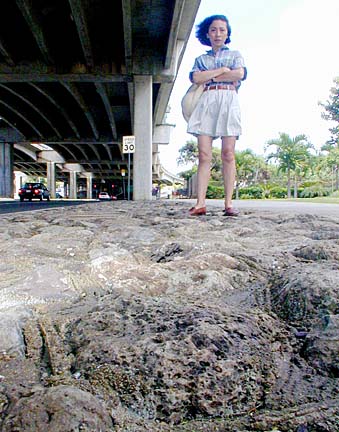Advertisement - Click to support our sponsors.


The Waialae Kahala Neighborhood Board will get to see what beautification under the freeway near Kahala Mall will look like Thursday. Waialae resident,
state clash over
roadside landscapingBy Harold Morse
Star-BulletinBut Waialae resident Lee Manfredi already knows she won't like it: there won't be enough greenery along the mauka sidewalk.
The matter has become a political battle between some community members and the state Department of Transportation, Manfredi said. "The original design was for the whole area to be greenery."
The state is expected to present visuals of what the project will look like at the Waialae-Kahala Neighborhood Board meeting at 7 p.m. Thursday at Wesley United Methodist Church, 1350 Hunakai St., said Martin Schiller, neighborhood board vice chairman.
Although the state plans to put in some greenery, it's much less than originally called for, Manfredi said.
She first discussed this with Kazu Hayashida, state transportation director, and a state landscape architect in 1995, and they then favored greenery for the entire stretch under the freeway along Waialae from 21st to Kilauea avenues, she said. Eventually, a design was produced to include plants, palm trees, vines on the fence, new grass and foliage along the sidewalk, Manfredi said.
The state plan to spruce up Waialae Avenue near the mall originally promised new paving, fence posts and chain-link fence, plus clearing and grubbing for landscaping and planting shrubs and palms, and the state included that data in press releases. Permanent irrigation lines to maintain greenery also were called for. But now in the blocklong stretch under the freeway from 21st Avenue to Hunakai Street rocks are going in without greenery on the mauka side.
Marilyn Kali, state transportation spokeswoman, said some low shrubs, ferns and other greenery are going in from Hunakai Street to Kilauea Avenue. Along with concrete and rocks along Waialae some greenery will be present, Kali said. "We are going to replace the fence (on the median)," she added. "We're going to replace it with a black chain-link fence."
"(State Rep.) Barbara Marumoto was able to get the ways and means committee to approve appropriation of $360,000, which took into account an inflation factor and maintenance," Manfredi said.
This was in 1997. But as time passed, funding proved inadequate and the project met with numerous delays and worry over who would do maintenance, and the design was completely changed, she said.
Finally only one-third of the original project survived, resulting in too much rocky surface that poses dangers to pedestrians who might fall and be injured on it and not enough greenery, Manfredi said.
Mary Steiner, Outdoor Circle chief executive officer, goes along with state efforts. "In some ways we're disappointed because we thought that we would be getting more -- more greenery, more beauty," she said. "But given the constraints of the project, we're also happy that we're not getting just planted rock. We've been working ... to come up with a good compromise," and this puts greenery along the mauka sidewalk from Hunakai to Kilauea, she said.